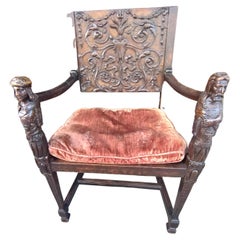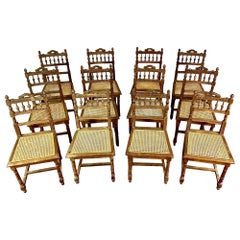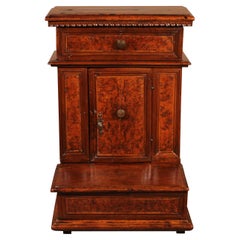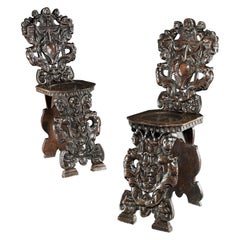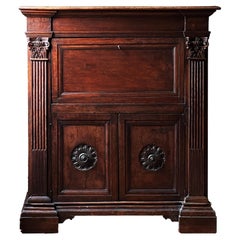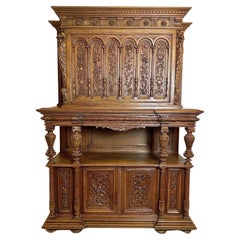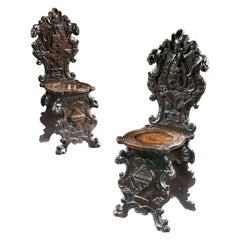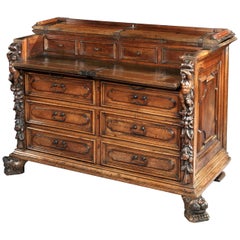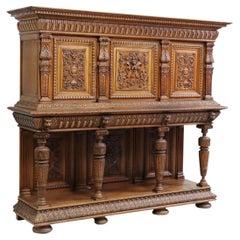Antique Renaissance Furniture
1750s Italian Renaissance Antique Renaissance Furniture
Walnut
19th Century French Renaissance Revival Antique Renaissance Furniture
Wood, Oak
16th Century Italian Renaissance Antique Renaissance Furniture
Walnut
16th Century Italian Renaissance Antique Renaissance Furniture
Walnut
17th Century Renaissance Antique Renaissance Furniture
Bronze
19th Century French Renaissance Antique Renaissance Furniture
Wood
Mid-19th Century Italian Renaissance Revival Antique Renaissance Furniture
Oak
16th Century Italian Renaissance Antique Renaissance Furniture
Walnut
Early 20th Century French Renaissance Antique Renaissance Furniture
Walnut
Late 19th Century German Renaissance Antique Renaissance Furniture
Brass
16th Century Realist Antique Renaissance Furniture
Wood
1880s French Renaissance Antique Renaissance Furniture
Marble, Bronze
16th Century French Renaissance Antique Renaissance Furniture
Walnut
16th Century Italian Baroque Antique Renaissance Furniture
Walnut
Mid-18th Century Dutch Renaissance Antique Renaissance Furniture
Oak
Late 19th Century French Louis XVI Antique Renaissance Furniture
Mahogany
16th Century Antique Renaissance Furniture
Oak
Early 17th Century French Louis XIII Antique Renaissance Furniture
Ebony
Late 17th Century Dutch Renaissance Antique Renaissance Furniture
Steel
1870s French Renaissance Revival Antique Renaissance Furniture
Walnut
1880s Antique Renaissance Furniture
Paper
19th Century French Renaissance Revival Antique Renaissance Furniture
Walnut
Early 1900s Renaissance Antique Renaissance Furniture
Oak
19th Century French Gothic Antique Renaissance Furniture
Wood, Walnut
Early 1900s Renaissance Antique Renaissance Furniture
Oak
16th Century French Renaissance Antique Renaissance Furniture
Bronze
16th Century French Renaissance Antique Renaissance Furniture
Walnut
16th Century French Renaissance Antique Renaissance Furniture
Walnut
19th Century French Renaissance Antique Renaissance Furniture
Oak
16th Century Renaissance Antique Renaissance Furniture
Walnut
Early 19th Century Swedish Renaissance Antique Renaissance Furniture
Iron
19th Century Renaissance Antique Renaissance Furniture
Wood
1920s American Renaissance Revival Antique Renaissance Furniture
Mahogany
16th Century French Renaissance Antique Renaissance Furniture
Walnut
Late 19th Century European Renaissance Revival Antique Renaissance Furniture
Mahogany
16th Century French Renaissance Antique Renaissance Furniture
Walnut
19th Century Italian Renaissance Antique Renaissance Furniture
Wood
19th Century Italian Renaissance Antique Renaissance Furniture
Velvet, Walnut
19th Century Italian Renaissance Antique Renaissance Furniture
Velvet, Walnut
19th Century Italian Renaissance Antique Renaissance Furniture
Fabric, Walnut
16th Century French Renaissance Antique Renaissance Furniture
Walnut
19th Century Renaissance Revival Antique Renaissance Furniture
Walnut
19th Century Swedish Renaissance Revival Antique Renaissance Furniture
Ash
1890s French Renaissance Antique Renaissance Furniture
Leather, Oak
Early 17th Century English Northern Renaissance Antique Renaissance Furniture
Walnut
Early 20th Century Renaissance Revival Antique Renaissance Furniture
Hardwood
1920s European Renaissance Antique Renaissance Furniture
Gold Leaf
Early 20th Century Renaissance Revival Antique Renaissance Furniture
Marble
19th Century Renaissance Antique Renaissance Furniture
Gold
19th Century European Renaissance Antique Renaissance Furniture
Suede, Fabric, Walnut
17th Century Italian Renaissance Antique Renaissance Furniture
Walnut
17th Century Italian Renaissance Antique Renaissance Furniture
Walnut
Early 20th Century Belgian Renaissance Revival Antique Renaissance Furniture
Oak
Early 20th Century French Renaissance Antique Renaissance Furniture
Oak
1850s Swedish Renaissance Revival Antique Renaissance Furniture
Walnut
19th Century English Renaissance Antique Renaissance Furniture
Walnut
Early 20th Century European Renaissance Antique Renaissance Furniture
Brass, Pewter
19th Century Italian Renaissance Antique Renaissance Furniture
Walnut
19th Century Italian Renaissance Antique Renaissance Furniture
Walnut
Late 17th Century Italian Renaissance Antique Renaissance Furniture
Iron
- 1
- ...
Antique Renaissance Furniture For Sale on 1stDibs
How Much is a Antique Renaissance Furniture?
- What makes furniture an antique?1 Answer1stDibs ExpertAugust 15, 2019
A piece of furniture is considered an antique if it is at least 100 years old.
- 1stDibs ExpertApril 5, 2024To know if your furniture is antique, look for labels and markings that indicate the maker. From there, you can use trusted online resources to determine when they were active and examine images to try to estimate the age of your piece. Furniture produced 100 years ago or more is antique. You can also have your furniture assessed by an appraiser or antiques dealer to learn about its age. On 1stDibs, explore a large collection of antique furniture.
- 1stDibs ExpertFebruary 22, 2021Antique furniture can be worth quite a lot, particularly if it is in good quality. The rarer the piece, the higher the value.
- 1stDibs ExpertFebruary 22, 2021There are a number of factors that can indicate if your antique furniture is valuable. When determining the value of antique furniture, consider its rarity. Additionally, it is important to determine the quality and condition of vintage furniture. If unsure of the value of your vintage furniture, have it appraised.
- 1stDibs ExpertFebruary 1, 2024To date antique furniture from the UK, first look for identifying markings on the piece. You can then use trusted online resources to determine when the maker was active. From there, you may be able to estimate the year of production by looking at images of other furniture the maker produced. An expert appraiser or antiques dealer can also aid you in the dating process. Find a large selection of antique furniture on 1stDibs.
- 1stDibs ExpertFebruary 13, 2024Whether antique furniture is making a comeback is a matter of opinion. Many people would argue that antique furniture never faded from fashion, as there have always been individuals who love the idea of owning pieces that have history. Some of the most popular styles for antique furniture include Art Deco, Arts and Crafts, Renaissance Revival, Elizabethan, Gothic Revival, Victorian and Chippendale. Find a large collection of antique furniture from some of the world's top dealers on 1stDibs.
- 1stDibs ExpertOctober 5, 2021The best finish for antique furniture is a matter of liking. But film finish is recommended by experts as it leaves a thick coat of film on the wood surface which protects wood from water and scratches. Shellac or varnish and water base are commonly used film finishes. Find an exquisite collection of antique, new and vintage furniture on 1stDibs
 PAGODA REDOctober 7, 2020
PAGODA REDOctober 7, 2020To determine the age of a Chinese furniture piece, look carefully at the joinery and finish. Natural expansion and contraction of the wood over time will cause a joint to protrude or retract, distorting a once-seamless fit. Antique lacquer finishes become crackled and worn over time. Areas of exposed wood, such as the underside of a table, the footrest of a chair, or the back of a cabinet should appear raw and dry compared to the finished surface. With use, the legs of tables and chairs become weathered near the bottom from precipitation and use.
- 1stDibs ExpertJanuary 25, 2019
The difference between vintage and antique furniture is that vintage furniture is at least 20 years old, while antiques must be at least 100 years old to be considered antique.
